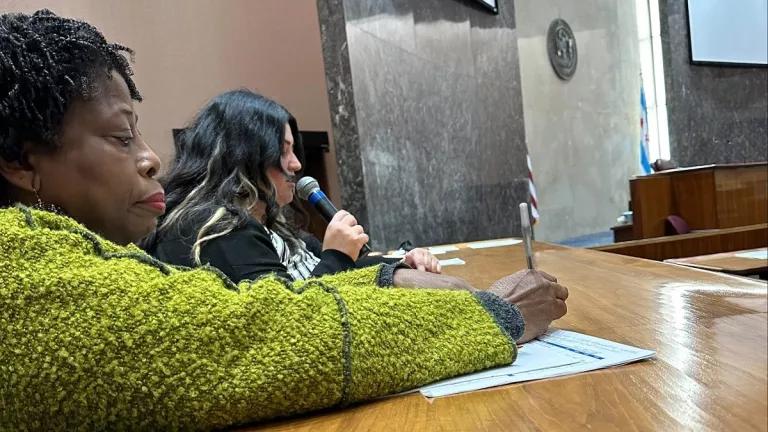Cities at the Crossroads of Consumption and Sustainability

For cities, nothing short of their survival as centers of commerce, community, innovation and vitality is at stake.
Imagine a Los Angeles with more cars, more working poor, higher housing prices and dirtier air. Or a Washington, D.C., with more displacement of long-time residents, more traffic, more sprawl and a stagnant transit system. Or Houston, with more flood threats, Phoenix with ever-increasing temperatures, and New York City with even higher rents.
Cities like these – many faced with a historic increase in population – understand that this more-of-the-same approach is pushing them toward a tipping point in their ability to grow and thrive.
For centuries, cities have inspired architects and planners, dreamers and poets, the rich and the poor, and today they are enjoying a resurgence that beckons youth, the middle class and retirees alike to their culture and “broad shoulders” with room and opportunity for all.
But our growing urbanization marks a new era at the complex intersection of economics, history and culture of the 21st century – one overlaid by a global climate crisis that requires a rethinking of policies and practices of the past.
Such policies, for example, often meant building emissions-spewing highways or power plants in the middle of neighborhoods, implementing so-called urban renewal programs that amounted to land grabs, and plastering over coastlines and natural water systems with impermeable concrete. They meant unfettered construction of giant energy-wasting buildings, millions of tons of methane-producing garbage and waste, an automobile and carbon economy, and outdated infrastructure that fails in the face of extreme storms and temperatures.
The oft-cited statistics are that cities consume more than two-thirds of the world’s energy, accounting for over 70 percent of carbon emissions globally, contributing to health risks, early death, international political insecurity, and diminished opportunity and well-being. By 2030, two-thirds of the world’s population will be living in cities, with the geographical area covered by cities potentially tripling.
But if cities are part of the global climate-change problem, they are also at the heart of the solution. And, as we’ve noted in our own work, they are, in fact, learning to become masters at not only managing but leading the world in creating sustainable places to live and work, while helping to foster unity and improve systemic cultural challenges.
In the United States, for example, more than 25 cities in 17 states, with populations totaling more than 5 million, have adopted resolutions that will enable them to get 100 percent of their electricity from renewable sources like wind and solar—with Atlanta being among the latest and leading the South. Overall, 18 of the top 20 most populous cities—with an estimated population of more than 30 million Americans—have set a quantified emissions reduction target, with more than 400 U.S. “Climate Mayors” pledging to commit to the goals laid out in the Paris climate agreement to reduce emissions by 80 percent by 2050. These mayors have made it clear they intend to push forward with the Paris goals despite the Trump administration’s withdrawal.
A growing number of city leaders also recognize that the devastation wrought by increasingly harsh storms and temperatures negatively affect communities of color and families who are already struggling financially, leading to more racial division and lowered opportunity for all. Solutions can be found in prioritizing infrastructure and revitalization that address economic, racial and equity issues.
For example, the San Francisco Bay area is working to preserve affordable housing in Oakland to keep working families near jobs and reduce the carbon pollution caused by displacement to faraway suburbs. Chicago is addressing entrenched structural inequities by working with low-income residents in four key communities to revitalize infrastructure to make it more resilient. Atlanta is creating a “New Atlanta Way” to increase opportunity and resources for low-income residents around transit stations, and Denver is strengthening neighborhood engagement to counter potential inequitable impacts from a recently completed transit expansion, among other examples.
Such ground-level approaches reveal the both global and local effects of work in cities, so if all of this seems beyond individual action, believe me, it’s not.
As I’ve said before, much of what we do to make our communities safe, healthy, and economically robust are the same as what can help us adapt to, and curb the effects of climate change.
Are we making sure our communities have a disaster preparedness plan, for example, or are we using efficient forms of transportation and incorporating energy efficiency in our homes? Do we promote green infrastructure and green open space that both mitigate for flooding and bring neighbors together? Are we promoting diversity in our neighborhoods and fighting the displacement that often precedes higher property costs and rents?
In short, cities and their diverse citizens are learning from and adapting to climate effects with the understanding that doing so will make them more prosperous and healthy. Embracing resilience and sustainability is the only way forward if cities are to live up to their reputations as the just and thriving places that culture and history portray them to be.
Editor’s Note: This essay was published in a book distributed to participants of the American Institute of Architects Conference 2018 in New York City.




